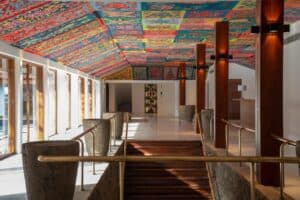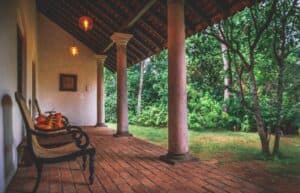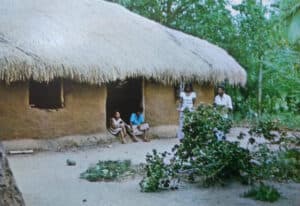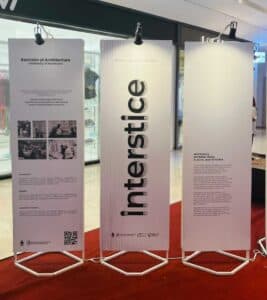Barbara Sansoni

Figure 1: Barbra Sansoni
Barbara Carolyn Sansoni Lewcock was a pioneering entrepreneur who redefined leadership with creativity and purpose in a male-dominated world. Born on April 22, 1928, in Kandy, Sri Lanka, she came from a Burgher family with diverse European roots. Her education took her from Sri Lanka to Southern India and later to London, where she studied at Chelsea Art School after World War II. Barbara’s return to Ceylon marked a vibrant chapter in her life, where she married Hildon Sansoni and raised their sons, Simon and Dominic.
Barbara’s early love for art and a deep appreciation for color shaped her career. The vibrant hues of South Asia profoundly influenced her, becoming a constant inspiration in her painting and textile design. Throughout her life, she worked across various fields, including textiles, painting, and writing.
Barbra’s journey as a textile designer:
Barbara transformed vibrant threads into powerful symbols of resilience, culture, and empowerment. Her work was deeply inspired by the rich colors of the surrounding culture and nature.
“My entire source of inspiration has been this Island. Traveling all over I have been overwhelmed by its wonder, inspired by its colour. Design emerges from one’s daily life; it has for me.” Said Babra once.

Figure 2: Inspiration from nature and culture © Barefoot

Figure 3: Piles of folded sarongs © Barefoot
Barbra Sansoni’s exceptional sense of color, inspired by Sri Lanka’s vibrant landscapes and culture, shaped her journey as a designer. Returning from England in the 1950s, she began designing fabrics for weaving centers in the 1960s, which led to the creation of the Barefoot brand. Adapting to material shortages, she dyed Indian cotton with Swiss dyes, drawing inspiration from Piet Mondrian and Bauhaus influences. By 1962, she was selling her fabrics under the label Barbara Sansoni Fabrics, collaborating with rural weaving cooperatives.
In the 1970s, she opened two shops, House in fort and Barefoot, introducing the versatile ‘reddha’ and a variety of colorful garments. Her innovative handloom designs not only defined Barefoot as a distinctive brand but also empowered rural women by providing sustainable livelihoods through weaving, sewing, and embroidery.

Figure 4: Clothing © Barefoot

Figure 5: Handloomed Bedspreads, cushion covers and curtains © Barefoot

Figure 6: Handloomed bags © Barefoot

Figure 7: Handloomed toys © Barefoot
Barbra Sansoni revitalized Sri Lanka’s traditional handloom industry, empowering women through sustainable entrepreneurship. In the 1970s, her vibrant designs attracted tourists and hotels, sparking a thriving export business. The Barefoot shop on Galle Road evolved into a cultural hub, featuring a bookstore, art gallery, café, and performance space, serving as a vital gathering place even during the civil war.

Figure 8: Barefoot shop © tripadvisor.com
Barbra as an artist and a writer:

Figure 9: Barbra Sansoni © Barefoot
Fascinated by the bright and vivid allure of color, Barbra began painting and drawing at an early age. Her artistic talents were nurtured by several dedicated teachers, including J.D. Perera and Professor G.M. Amarasinghe.

Figure 10: Barbara Sansoni’s cartoon drawings from many years ago © Barefoot
She illustrated birds and creepers along the staircase of St. Bridget’s Montessori, a building designed by Geoffrey Bawa in 1960.

Figure 11: Staircase at St. Bridget’s Montessori © Lunuganga trust
Barbra Sansoni engaged in sculptural work, collaborating on unbaked tiles with Donald Friend and creating significant religious art, including the Risen Christ, 14 Stations of the Cross, and Psalm of the Good Shepherd for the Chapel of the Good Shepherd in Bandarawela.

Figure 12: Chapel for the Good Shepherd Convent © misterngo

Figure 13: The stations of the cross on terracotta by Barbra Sansoni © Achini Jayarathne
Barbra Sansoni’s figure drawings emphasized genetic heritage, capturing distinct features like cheekbones, nostrils, hair curls, and lips. She once suggested the title ‘Races in the Face’ for her book.

Figure 14: Detail of “Upeka” (Upeka Chitrasena) in 1993. Watercolor & ink on paper © Babra Sansoni
“I have always been drawing what caught my eyes. It was Dr. R.L. Spittel who advised me never to be without a sketch book in hand. … My entire source of inspiration has been this Island. Travelling all over I have been overwhelmed by its wonder, inspired by its color. Design emerges from one’s daily life; it has for me…. Everything changes with light, between monsoons. Nothing is so magical as a tropical twilight, as natural light fades and artificial light comes on. The colors in the celestial hemisphere are unbelievable.” Said Barbra
In the 1950s and 60s, Barbra Sansoni worked as a freelance journalist, contributing weekly feature articles, children’s stories, and illustrations to the Daily Mirror. Her work expanded to include poems, letters, sketches, and books, gaining wider recognition.

Figure 15: Illustrations by ©Babra Sansoni
In the 1960s, Barbra Sansoni wrote stories for her children, adding her own whimsical illustrations of animals and creatures in playful settings, reflecting both childhood innocence and humor. These were later published in the books Missy Fu and Tikkiri Banda (2002), Missy Fu in Yala (2015), and Press with the Toes (2003).

Figure 16: A birthday card from Grandma © Barbra Sansoni

Figure 17: Missy Fu and Tikkiri Banda © Barbra Sansoni
Barbra Sansoni was the last surviving member of a pioneering group of designers and artists, including Bevis and Geoffrey Bawa, Ena de Silva, and Laki Senanayake, who emerged after Ceylon gained independence. She collaborated with Ulrik Plesner, Laki Senanayake, and Ismeth Raheem to document old buildings and provided color schemes for many buildings designed by her close friend, architect C. Anjalendran, including the SOS Children’s Villages.
In the 1960s, disturbed by the demolition of traditional buildings, Barbra took it upon herself to document them through drawings and published essays such as Sri Lankan Vernacular (1990) and Leila’s Road (1963) which reflected her deep interest in preserving and understanding the architectural heritage.

Figure 18: Atapattu walawwaGalle ‘ 73 © Barbra Sansoni

Figure 19: On road to Galle ‘ 62 © Barbra Sansoni

Figure 20: The Jaffna Kitchen © Barbra Sansoni

Figure 21: Ambalama Kadugannawa pass ‘82 © Barbra Sansoni

Figure 22: Yakadagala ’64 © Barbra Sansoni

Figure 23: Post office on road to Galle © Barbra Sansoni

Figure 24: Lankathilake drumming hall ‘63 © Barbra Sansoni
In 1983, Barbra Sansoni married architectural historian Ronald Lewcock and with his encouragement, she continued documenting and studying old buildings. In 1998, he urged her to publish the remarkable book ‘Architecture of an Island’, which featured a vast collection of drawings she and Laki Senanayake had created, complemented by his insightful texts.

Figure 25: Architecture of an Island © Barefoot
She received numerous awards throughout her life, including:
- 1987 – Zonta Woman of Achievement, from the Zonta Club of Colombo
- 1997 – Woman Entrepreneur of the Year (Gold award) by the Women’s Chamber of Industry & Commerce
- 1999 – Sri Lankan Entrepreneur of the Year, by the Federation of Chamber of Commerce & Industry of Sri Lanka
- 2005 – Kala Suri Award from the President of Sri Lanka
- 2011 – Geoffrey Bawa Award for contribution to architecture
- 2016 – Honorary Doctor of Philosophy for the distinguished service rendered to the field of visual arts from the University of the Visual and Performing Arts, Sri Lanka
- 2017 – Inspirational Woman of the Year award, from the Organization of Professional and Career Women – Women in Management
Her work has been widely exhibited, with international exhibitions beginning in 1966, including a showcase of her drawings and woven panels at the former Ceylon Tea Centre in London, where her vibrant fabric designs and depictions of traditional Sri Lankan architecture were displayed.

Figure 26: Barbra at Ceylon Tea Centre in Lond in 1966 © ARTRA Magazine
Barbra Sansoni’s passing on April 23, 2022, just an hour after celebrating her 94th birthday, marked the end of a remarkable life dedicated to preserving and celebrating Sri Lanka’s heritage through art, design, and culture. Her work, which spans multiple disciplines, continues to inspire and influence generations of artists, designers, and thinkers. In her own words, she encapsulated the essence of Sri Lanka’s beauty and richness:
“Pearl of the East
Amethyst and Turquoise,
Aquamarine drops
On Emeralds Isle of
Gem Pits and Gem Mine.
Sapphires with stars.
No need to go Gemming.”
Her legacy, like the gems she described, remains timeless, continuing to shine brightly in the cultural landscape she so deeply enriched.
Reference:
https://island.lk/death-of-barbara-carolyn-sansoni-lewcock/
https://island.lk/barbara-sansoni-a-unique-person/
https://www.sundaytimes.lk/220501/plus/barbara-sansoni-shades-of-a-pioneer-481104.html
https://www.hi.lk/feature/The-handloom-revolutionary/30-6645
https://kalalanka.wordpress.com/2022/03/15/barbara-sansoni/
https://www.instagram.com/misterngo/p/CYlUxLDFlqf/?img_index=8
Related Posts

How Traditional Sri Lankan Textiles Shape Modern Contemporary Interiors
November 12, 2025

City of Dreams
October 22, 2025

“From Dream to Reality” – The Sri Lankan Building Process
October 8, 2025

Why Sri Lankans Love Verandahs
October 1, 2025

Why Old Sri Lankan Houses Always Felt Cooler?
September 10, 2025

Interstice – Where Architecture Meets the In-Between
September 3, 2025
